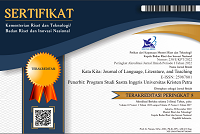THE CHOICE OF CODES USED BY TWO ANNOUNCERS OF DJ FM AND SS FM RADIO STATIONS IN THEIR ADVERTISEMENTS
DOI:
https://doi.org/10.9744/katakita.2.2.54-61Keywords:
Interior Design, Interior, Restaurant, Multi-cultureAbstract
This thesis is a study of the choice of codes used by the announcers of DJ FM and SS FM radios in their advertisements, consisting of twenty advertisements from both radios. I applied some theories of codes from Wardaugh (2006), Stockwell (2002), and Holmes (2001) as my main theories. Also, I used the theory of Age and Linguistic choice from Coulmas (2005), and Marketing and Language Choice from Victor (2007) as my supporting theories. The subjects are two announcers of DJ FM and SS FM radios which are in the phase of young adulthood. Furthermore, I found that the announcers from both radio stations used Standard Indonesia as their main code. The conclusion is the target audience of DJ FM and SS FM did not influence the way the announcers chose their codes.References
Coulmas, F. (2005).Sociolinguistics: The study of speakers’ choices. Cambridge: Cambridge University Press
Djupri, M. (2008).Kamus Suroboyoan-Indonesia. Surabaya: Henk Publica.
Goldstein, E. B. (2008). Cognitive psychology: connecting mind, research, and everyday experience, 2nd ed.Belmont, CA: Thomson Wadsworth
Holmes, J. (2001). An introduction to sociolinguistic. Harlow: Pearson Education Limited.
Indonesia. Departemen Pendidikan Nasional. (2008). Kamus besar bahasa Indonesia pusat bahasa Ed. 4.Jakarta: PT Gramedia Pustaka Utama.
Johansen, G. (2010). A study of radio as an advertising media - and the impact of creativity. Retrieved September 1st, 2013 from
http://studenttheses.cbs.dk/bitstream/handle/10417/1761/gitte_johansen.p df?sequence=1
Kridalaksana, H. (1993).Kamus linguistic. (3red). Jakarta: PT. Gramedia Pustaka Utama.
Krishna, A. & Ahluwalia, R. (2008). Language choice in advertising to bilinguals: asymmetric effects for multinationals versus local firms. Retrieved August 26th, 2013 from http://www.carlsonschool.umn.edu/assets/108422.pdf
Moleong, L. J. (2005). Metode penelitian kualitatif. Bandung: PT. Remaja Rosdakarya.
Pateda, M. (1990).Sociolinguistic. Bandung: Angkasa.
Robson, S. (2002). Javanese English dictionary. Singapore: Periplus Editions.
Roosman, L. (2003). Melodic structure in Toba Batak and Betawi Malay word prosody.Retrieved June 1st, 2013 from http://lotos.library.uu.nl/publish/articles/000208/bookpart.pdf
Sasangka, S. S. T. W. (2004). Unggah-ungguh bahasa Jawa.Jakarta: Yayasan Paramalingua
Stockwell, P. (2002). Sociolinguistics: a resource book for students. London: Routledge
Sukanta.(2010). Kamus sehari-hari bahasa Betawi. Jakarta: Gramedia Widiasarana Indonesia
Victor, D. A. (2007). What is the language of business? affecting business outcome before you say a word. Retrieved September 7th, 2013 from
http://businesscommunication.org/wpcontent/uploads/2011/04/02ABCAsi aPac07.pdf
Wardhaugh, R. (2006). An introduction to sociolinguistics.(5th Edition). Oxford: Blackwell.
Wiryanti, S. W. (1993). Pengetahuan bahasa Indonesia.Unpublished book.Petra Christian University, Surabaya.
Downloads
Issue
Section
License
Authors who publish with this journal agree to the following terms:- Authors retain copyright and grant the journal right of first publication with the work simultaneously licensed under a Creative Commons Attribution License that allows others to share the work with an acknowledgement of the work's authorship and initial publication in this journal.
- Authors are able to enter into separate, additional contractual arrangements for the non-exclusive distribution of the journal's published version of the work (e.g., post it to an institutional repository or publish it in a book), with an acknowledgement of its initial publication in this journal.
- Authors are permitted and encouraged to post their work online (e.g., in institutional repositories or on their website) prior to and during the submission process, as it can lead to productive exchanges, as well as earlier and greater citation of published work (See The Effect of Open Access).














